by Derek Teed
June 2024
Minnesota's official unemployment rate is a useful indicator of the health of the state's economy, but it does not tell the whole story. We can get a more complete picture of Minnesota's labor market by looking at alternative measures of unemployment, and by providing the rates by age, gender, and race. The numbers below come from the Current Population Survey.
Use these estimates with caution. The Current Population Survey, which produces these data, has a sample size of only 900 households in Minnesota making it too small to publish monthly estimates for subpopulations. This report uses the BLS unpublished 12-month moving averages. Rolling together 12 months of data is the most reliable method of publishing estimates for subpopulations in Minnesota but means that turning points in the data lag by six months. Moreover, even rolling 12 months of data together results in high standard errors on the estimates, reliability issues, and limitations on which demographic groups can have labor force estimates published. Essentially, the data provided in this report should be viewed as indicators rather than as reliable estimates.
The Bureau of Labor Statistics has developed alternative definitions of unemployment and underemployment (see Table 1). The official unemployment measure, called U-3, is the share of those aged 16 and over who, at the time of the monthly survey, were not employed in the past week and who looked for work sometime in the past four weeks. U-3 excludes anyone who was not seeking work in the past month unless they were temporarily unemployed and have a date by which they will return to the same employer. This group, those not seeking work, is considered not in the labor force. Note that the U-3 number reported in this analysis will differ from the official state unemployment estimate because it is based on a 12-month moving average.
The U-4 adds people who want a job but aren't actively searching because they think there are no jobs available that fit their qualifications, also known as discouraged workers, to the count. Discouraged workers are those who have looked for work in the past year but stopped looking in the past month because they think they cannot find a job.
U-5 adds all the other "marginally attached" workers, people who looked for work sometime in the past 12 months but, for reasons other than discouragement, did not look in the past four weeks, to the count of unemployed.
The broadest measure of unemployment, U-6, includes all the above and adds people who are employed part-time but want full-time work.
| Table 1. Alternative unemployment rates in Minnesota as of May 2024 (12-month moving averages) | |||||
|---|---|---|---|---|---|
| Measure* | May-24 | April-24 | May-23 | Monthly Change | Annual Change |
| U-3 | 2.8% | 2.9% | 2.9% | -0.1% | -0.1% |
| U-4 | 3% | 3% | 3% | 0% | 0% |
| U-5 | 3.5% | 3.5% | 3.8% | 0% | -0.3% |
| U-6 | 5.4% | 5.4% | 5.3% | 0% | 0.1% |
| Number of Discouraged Workers | 5,000.00 | 5,000.00 | 3,500.00 | 0 | 1500 |
| Number of Involuntary Part-Time Workers | 60,900 | 57,900 | 47,000 | 3000 | 13900 |
*Definitions of Measures:
U-3 Official unemployment rate
U-4 Discouraged plus officially unemployed
U-5 All marginally attached (including discouraged) plus officially unemployed
U-6 Involuntary Part Time plus marginally attached, discouraged, and officially unemployed
Involuntary Part time—a component of U-6, including only persons working less than 35 hours per week who want, but cannot find, a full-time job. Some usually work full-time but are currently working part time. Some usually work part time but would prefer to work full time.
Long-term unemployment—lasting more than 27 weeks —imposes costs on people that go well beyond lost wages, including lower future earnings (see Table 2).
| Table 2. Long-term unemployment | |||||
|---|---|---|---|---|---|
| Measure* | May 2024 | March 2024 | May 2023 | Monthly Change | Annual Change |
| Number Long-Term | 4,500 | 5,200 | 9,200 | -700 | -4,700 |
| Share Long-Term | 5.1% | 5.8% | 10.3% | -0.70% | -5.20% |
| Median Duration of Unemployment (weeks) | 7.2 | 7.4 | 7.8 | -0.20 | -0.60 |
*Long term is defined as more than 27 weeks. The share of long term is expressed as a percentage of all unemployed (U-3).
The labor force participation rate for Black Minnesotans was 75.8% in May, which is 2.9 points higher than one year ago and well above the labor force participation rate for white Minnesotans. The employment to population ratio was 72.9% in May, up from 71.2% a year ago. The unemployment rate was 3.9% in May, up 1.5 points from a year ago.
The labor force participation rate for Hispanic Minnesotans was 73.4% in May, down 2.0 points over the year. The employment to population ratio was 70.8% in May, down 0.3 points from one year ago. The unemployment rate was 3.6% in May, down from 5.7% a year ago.
The labor force participation rate for White Minnesotans was 67.7% in May, up 0.5 points over the year. The employment to population ratio was 66.0%, 0.7 points higher than last year. The unemployment rate was 2.5% in May, down 0.3 points over the year.
The labor force participation rate for Asian Minnesotans was 73.7% in May, up 5.0 points over the year. The employment to population ratio was 72.3%, up 5.8 points compared to last year. The unemployment rate was 1.9% in May, down 1.4 points over the year.
The labor force participation rate for Native American Minnesotans was 57.4% in 2017 to 2021 compared to 69.2% for the total population age 16 and older. The employment to population ratio for Native American Minnesotans was 49.9% compared to 66.3% for the total population and the unemployment rate was 12.9% compared to 4.0% for the total population. These are l five-year estimates from the American Community Survey and are not comparable to the numbers elsewhere in this article.
Figures 3, 4,, and 5 display labor force participation rates, employment to population ratios and unemployment rates for the total population, Black, Hispanic, and White Minnesotans for the current months and comparisons to previous years, same month, using 12-month moving averages.
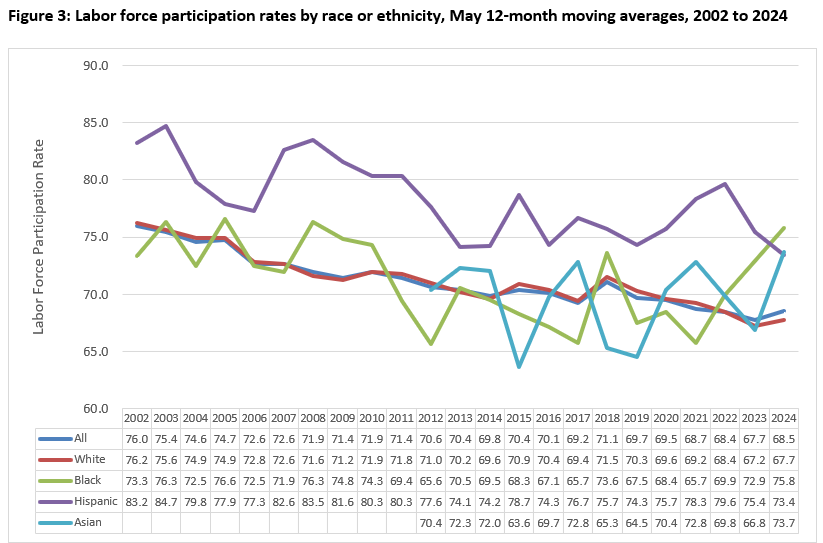
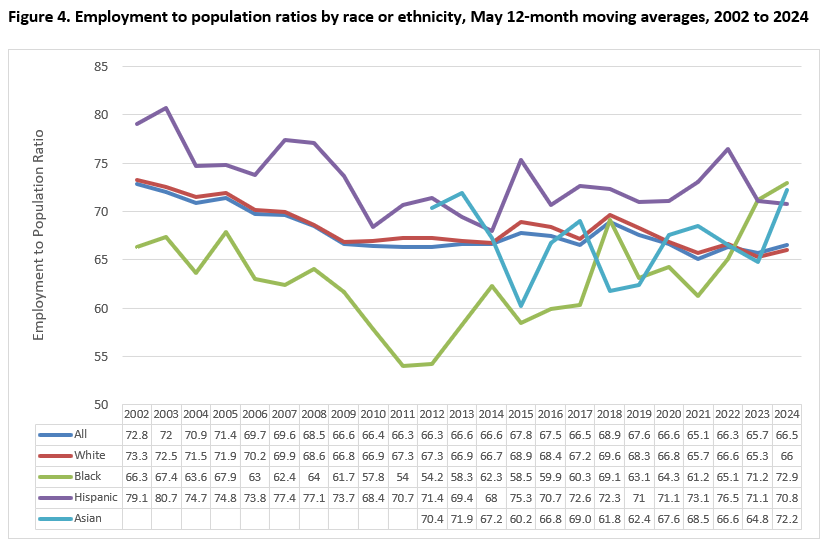
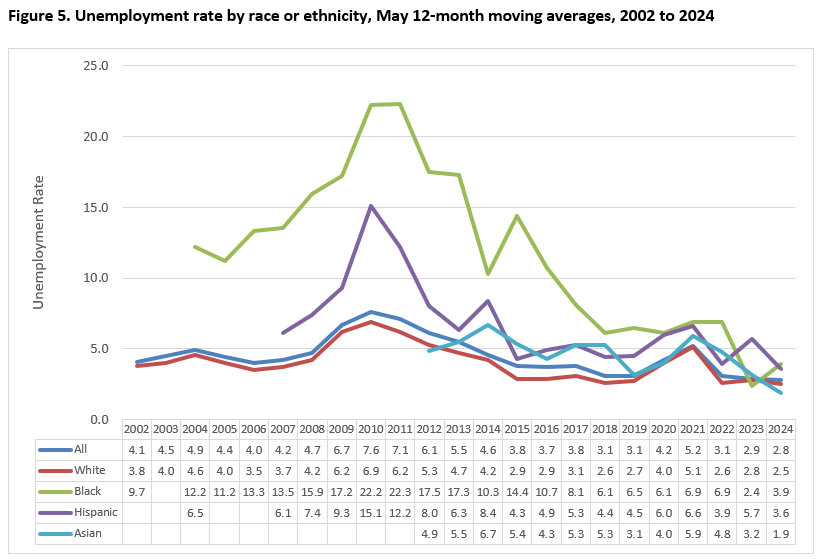
Note: Owing to the small sample size for Black, Hispanic, and Asian workers in the Current Population Survey, the unemployment estimate and unemployment rate are subject to high volatility for these groups. The unemployment rate is valuable and meaningful when examined as a long-term trend, not month-by-month.
The labor force participation rate for women was 65.8% in May, which was up 2.0 points from one year ago. The employment to population was 64.1% in May, up 1.7 points from one year ago. The unemployment rate dropped to 2.6% in May and was up 0.4 points over the year.
The labor force participation rate for men was 71.1% in May, 0.5 points lower than a year ago. The employment to population ratio was 68.9%, down 0.2 points from one year ago. The unemployment rate was at 3.0% in May and was down 0.5 points over the year.
| Table 6. Labor force indicators by gender | ||||||
|---|---|---|---|---|---|---|
| Month/Year | Labor force participation rate | Employment to population ratio | Unemployment rate | |||
| Female | Male | Female | Male | Female | Male | |
| May-2024 | 65.8% | 71.1% | 64.1% | 68.9% | 2.6% | 3% |
| April-2024 | 65.9% | 71.5% | 64.1% | 69.3% | 2.7% | 3.1% |
| May-2023 | 63.8% | 71.6% | 62.4% | 69.1% | 2.2% | 3.5% |
| Monthly change | -0.1% | -0.4% | 0% | -0.4% | -0.1% | -0.1% |
| Annual change | 2% | -0.5% | 1.7% | -0.2% | 0.4% | -0.5% |
The teen (age 16-19) unemployment rate was 5.3% in May, down 2.2 points over the year, which puts the teen unemployment rate at a record low for a May going back to 2002, the beginning of this series. The labor force participation rate was 66.0%, and the employment to population ratio was 62.5%, both at records highs for May going back to 2002.
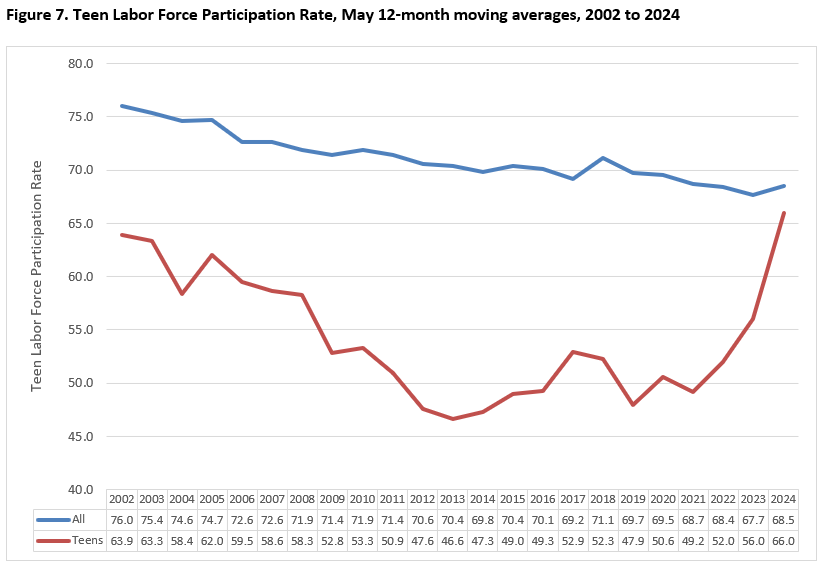
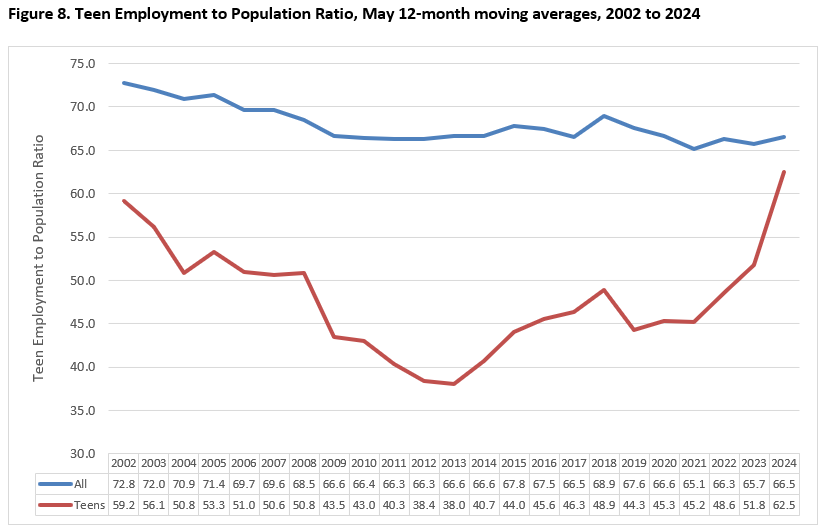 >
>
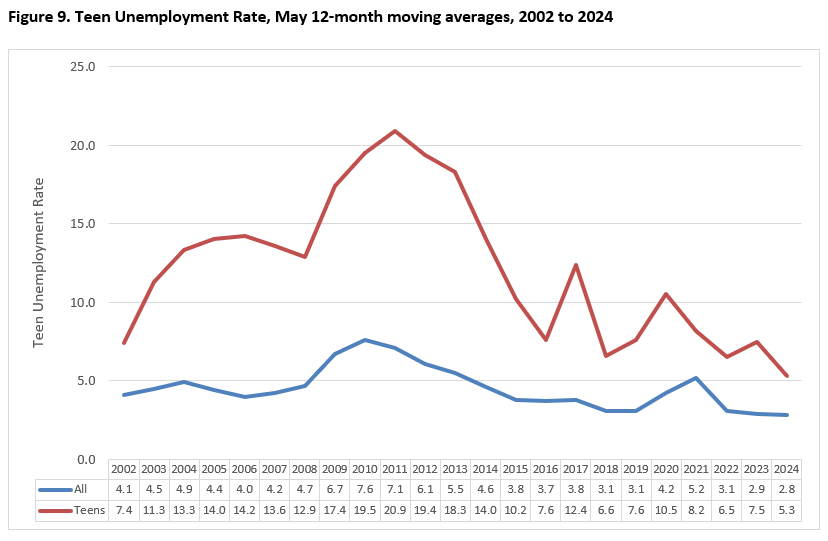
Note: Because of the small sample size for teen workers in the Current Population Survey, the unemployment estimate and unemployment rate are subject to high volatility. The unemployment rate is valuable and meaningful when examined as a long term trend, not month-by-month.